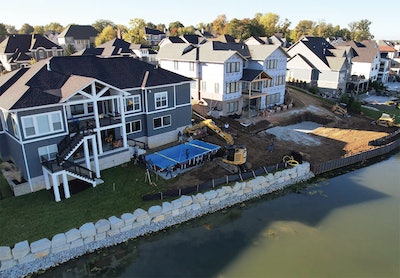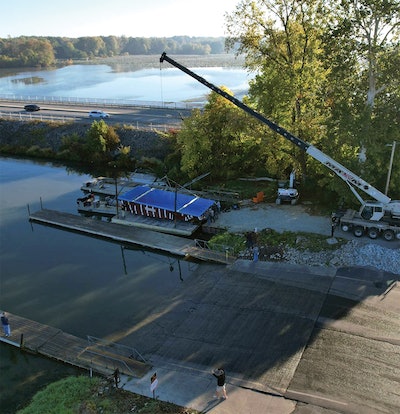Ok, so you are just moving a shell of a pool from one location to the next. Is that really a big deal or not?
It’s quite exciting, actually. It’s thrilling because it is not what it was intended to be. It is in an awkward position. It is not at home.
A fiberglass shell needs to be placed in a hole that is custom-fitted and backfilled with support material. It’s there, its home. The shell, which is large and heavy for its size, is transported from the flatbed trailer into the ground. It looks like a pterodactyl exhibit, but it’s on the way to a museum.
It can be moved over water with a wallowing scow that is seaworthy enough for you to use a tow rope to get it a few miles.
A pool in motion often attracts many people, regardless of whether it is suspended from a crane, or sailing over the waves.
The excitement is felt by everyone. It’s exciting, even though it is a little risky. The delicate flightless bird could fall to the ground or onto someone’s roof or onto the pavement. The excavator could tip over. The barged pool can send water and founder if there is a breeze.
It was all over. It will happen again on another day when the foreman takes a small chance and turns out to be unlucky.
Jonathan Hendrick, Hendrick Pool and Lawn Service, delivered three fiberglass pools to their shoreline waiting spots across a reservoir north from Indianapolis. The entire process from truck to dock to across the water and from hole to hole was meticulously planned.
Hendrick says that there were “definitely lots of spectators watching these pools travel by boat to their homes.”
The company uses this process regularly, so it was an encore performance. “I worked for a home builder who built many homes along a beautiful lake. The pools were all located just below the water’s edge.
It was much easier to bring these pools into the backyard from the water than to try to lift them onto huge homes far away from the road. This is an important measurement, the distance from the road to your house. You want it to be as short as possible because the setup point and reach radius of a crane are critical.
You want to reduce the swing. You will pay less to rent a crane if it is shorter than the distance. A crane is more difficult to use if it is a long distance from the house. There’s a driveway and perhaps a bigger crane.
A pool shell hanging from the bucket of an excavator can solve many of these problems inexpensively. However, it requires a path through the ground and its tracks can cause damage to your lawn. Hendrick Pool was interested in using the excavator, but it didn’t like the access routes to the house. So, it devised a new solution.
Hendrick states that “we just barged the excavator on the job first.” We not only saved money on a crane but also prevented any damage to the yard of the home by accessing it from water.
FIBERGLASS LAUNCH
The team had prepared and a solid plan, so the mission was underway by dawn. The flatbed was strapped with a Thursday Pools fiberglass shell and was attached to a Dodge Ram 3500. Soon, the journey was underway with “wide load” banners flapping in the breeze.
The shell was then transferred to the dock and placed on a barge that would be waiting in the water. Hendrick states that Deaton’s Waterfront Services was hired to manage all docks at the reservoir.
Deaton’s does not get many requests to build fiberglass pool boats. They serve Hendrick’s sailboat like any other. It was a beautiful day for sailing, with the weather being sunny and calm.
Hendrick considered faster options to speed up the process but decided against it in the interest of safety and caution, which are always priorities when moving shells.
He says that fiberglass pools are watertight and constructed in the same manner as sailboats. However, he decided to pull the pool behind a speedboat. But he said that he ultimately chose the barge because it would be the most secure. This would ensure the pool was not damaged by any objects it might encounter crossing the water. It is important to consider all possibilities.
The crew climbed on to the barge and then set off, putt-putt putting their boats across the water towards the other shore. The pool and barge were tied at the backyard seawall. Now it was time to move on to the final step. Shell, excavator, and hole were all there, so it was just a matter lifting the pool and placing it.
It is important to consider the lift force vectors that are applied to the fiberglass pool when moving a shell. They are easy to crack. The straps were attached at four points on the pool’s surface to the bucket of the excavator. To absorb the pinching force from the straps’ acute lift angle, a spreader bar was used.
A guide rope and around a dozen workers helped the pool to the gravel base at its bottom.
Complete transport. All around, high fives.
A FEAT OF ORGANIZATION
It is always important to plan for shipping a fiberglass pool. However, this delivery with the excavator and shell crossing the water in the backyard required a little more organization.
Hendrick states that it takes a lot of planning to get everyone on the right page. “All houses are located on the reservoir. High-water tables require that these pools be immediately plowed and filled with water in order to keep them secure.”
This type of special delivery has been a skill that the builder has developed, which has resulted in numerous pool contracts.

“We have been extremely fortunate. We have installed between 60 and 70% of the pools in this area alone. We installed five pools on Thursdays over the two-week period. Three were 16-by33-foot Goliath pools; one was 14-by35-foot Aspen pool; one was 16-by37-foot Goliath pool; one had a 9-by-9 fiberglass spa.
“For this particular circumstance, out of five jobs within the two-week period, all of them in the same neighborhood, we chose a barge to access four of the five pool areas.”
This article was first published in AQUA Magazine’s March 2023 issue. It is the best resource for builders, retailers, and service professionals in the spa and pool industry. All industry professionals can subscribe to the magazine for free. Subscribe by clicking here








